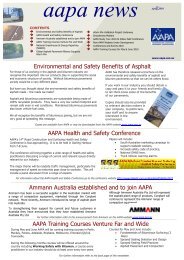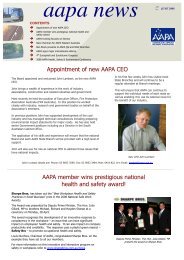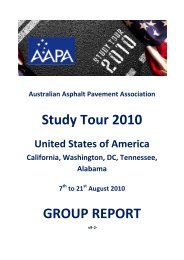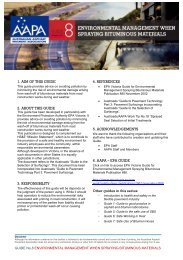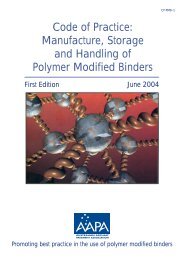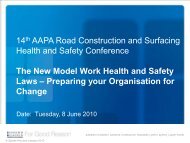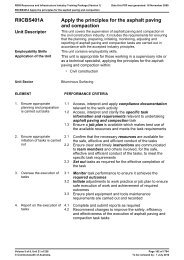Asphalt Review - Feb/March 2013 - Australian Asphalt Pavement ...
Asphalt Review - Feb/March 2013 - Australian Asphalt Pavement ...
Asphalt Review - Feb/March 2013 - Australian Asphalt Pavement ...
Create successful ePaper yourself
Turn your PDF publications into a flip-book with our unique Google optimized e-Paper software.
need to seek controls higher in the hierarchy of controls that depend<br />
less on behaviour.<br />
Internal Traffic Management Plans (ITMP) as described below should<br />
assist to improve site safety where mobile plant and vehicles are<br />
separated from pedestrian workers as far as practical from plant and<br />
truck operating areas.<br />
Everyone who works on road construction sites needs training<br />
to understand the risk of mobile plant and trucks where the driver/<br />
operator cannot see them.<br />
Safe Work Method Statements (SWMS) could seek to control this<br />
risk by requiring workers to be more than six metres from the rear of<br />
plant but it is safer to not be behind plant or within its swing radius at<br />
any time.<br />
The US National Institute of Occupational Safety and Health (NIOSH)<br />
has produced Construction Equipment Visibility Diagrams for most of<br />
the commonly expected mobile plant and vehicles. These diagrams<br />
show the operators visibility profiles around the plant from the<br />
viewpoint of the operator. The US Work Zone Safety Clearing House<br />
also produces a “Know the Blind Spots” Poster.<br />
Internal traffic management plans (ITMP)<br />
An ITMP is used to safely coordinate the interaction between<br />
pedestrians (workers and public), construction plant, delivery<br />
trucks and incidental visitors in the work space of a road<br />
construction work zone. In the US, they are referred to as Internal<br />
Traffic Control Plans (ITCP).<br />
Similar, but less sophisticated plans, have been used previously on<br />
VicRoads major project sites combined with UHF radio communications.<br />
However, the fundamental principles are applicable to all roadwork<br />
sites (including smaller sites) for internal traffic management.<br />
Based on the US experience, the fundamental principles for setting<br />
up an effective ITMP are:<br />
• Isolate workers and other pedestrians from mobile plant and works<br />
vehicles;<br />
• Reduce the need to back up;<br />
• Limit vehicle access points to work zone;<br />
• Coordinate truck and mobile plant movements;<br />
• Provide signs within the work zone to give guidance to pedestrian<br />
workers, equipment and trucks;<br />
• Design buffer spaces to separate pedestrian workers from errant<br />
vehicles and work zone equipment; and<br />
• Inform all on-site personnel of ITMP provisions.<br />
Two examples of the isolation of pedestrians from mobile plant and<br />
other vehicles on recent VicRoads major projects are:<br />
• Leighton Contractors introduced its Pedestrian No Go Zones on the<br />
M80 Upgrade Project early in 2011. It was the first highly visible<br />
ITMP to be introduced on a VicRoads Project. Leighton was recently<br />
presented with the VicRoads Major Project Safety Innovation Award<br />
in recognition of the establishment of the Pedestrian No Go Zones,<br />
and trial of GPS Personal Warning Devices for mobile plant operators<br />
and personnel authorised to work near plant, but outside of<br />
minimum approach distances.<br />
The concept had origins in the mining industry where they are<br />
sometimes called “Red Zones”. It requires compliance with behavioural<br />
controls, just as drivers are required to do on public roads but the<br />
system does isolate plant operations from pedestrians and gives the<br />
lead plant operator authority to give permission to other vehicles to<br />
enter the zone and pass other plant.<br />
Plant is required to stop all movement and rest the booms in the<br />
case of excavators pending the safe passing by plant and vehicles<br />
authorised to pass/enter the area. If it is necessary for a pedestrian to<br />
enter or approach plant they must seek permission over the radio and<br />
machines will be stopped until they are sighted and, if necessary, given<br />
permission to come closer.<br />
All permissions and instructions must be confirmed over the<br />
radio before entering the Red Zone. Some areas are made absolute<br />
Pedestrian No Go Zones where pedestrians entry is completely<br />
prohibited. Appropriate signage is then displayed.<br />
General Warning Sign – Also a reminder to contact the Lead Plant Operator by Radio<br />
and wait for permission to enter. Details of the radio frequency and name of the lead<br />
operator are provided on an adjacent Safe Notice Board. They are not provided if the<br />
area has been declared an absolute ‘Pedestrian No Go Zone’<br />
Safe Notice Board - Details are not provided when an area has been declared an<br />
absolute Pedestrian No Go Zone.<br />
• Working in a residential area always presents a challenge for road<br />
construction with respect to the separation of mobile plant and other<br />
construction vehicles from the public.<br />
BMD Constructions has just commenced the duplication of Clyde<br />
Road at Berwick in Victoria in an area where access to businesses<br />
and residences needs to be maintained and effective isolation of<br />
construction plant and vehicles from the public is necessary. BMD,<br />
together with VicRoads, is seeking more effective isolation between<br />
mobile plant and vehicles to achieve compliance with expectations in<br />
this area.<br />
ROADS FEB/MARCH <strong>2013</strong> 27



